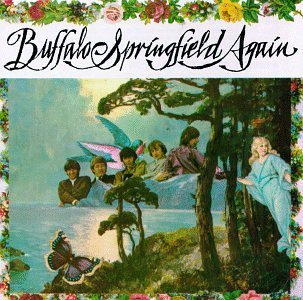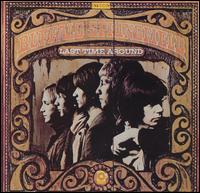Buffalo
Springfield
Albums reviewed on this page: Buffalo Springfield, Again, Last
Time Around
One of the most
important American bands for a couple of albums. I tend to think of them as America's answer to the mature Beatles.
Personnel: Steven
Stills (vocals, guitar), Neil Young (vocals,
guitar), Ritchie Furay
(vocals, guitar), Bruce
Palmer (bass), Dewey
Martin (drums). Young quit at least
once, and Palmer
left towards the end, replaced by Jim
Messina semi-officially.
 Buffalo
Springfield
(Dec. 1966),
****
Buffalo
Springfield
(Dec. 1966),
****
Buffalo
Springfield's debut helped mark the advent of political awareness and
more adventurous American music. The group's lone hit, Stills' "For
What It's Worth," is a strong transitional statement - dealing
with political events, paranoia, and seems to crop up on any
documentary about the 60s (it's the one that goes "Stop, hey,
what's that sound? Everybody look what's going down.").
Interestingly enough this track was added to the album in early 1967,
and the remainder is quite different. In its original form,
Springfield's debut continued the shift towards melodic
Beatles-influenced Americana, in contrast with more frequently heard
straight blues, R&B or folk-rock. No 12-string guitar leads,
fewer strummed basic folk tunes, and in their stead, more complicated
songs with tight harmonies. This is Rubber
Soul plunged
deeper with Americana, resulting in country inklings ("Hot Dusty
Roads", "Nowadays Clancy Can't Even Sing"), more folk,
blues ("Leave"), long enough for a couple of minutes of
good harmonies and intricate guitar leads. Yes, the Beatles are a
powerful influence ("Out of My Mind", the fuzz on "Sit
Down I Think I Love You"), but Stills and Young's
songs are stronger than mere knock-offs, setting the group apart from
the dozens of bands groping in the Beatles' wake. Young was the
better songwriter at this point - writing poetic, sometimes obtuse
lyrics, and matching them with relatively complex chord changes
("Nowadays Clancy Can't Even Sing"). Stills' talent is
marginally weaker, writing more direct lyrics (usually woman-aimed),
and musically simple melodies, although all of the Springfield's
songs could be sung by one person with a guitar. Stills' reliance on
repetition does result in the album's only true weak spots ("Hot
Dusty Roads" and the Eastern-influenced "Everybody's
Wrong"). The luxury of having both Stills and Young play lead
guitar has a large impact on their sound, allowing them to have two
different styles within the same song. The singing is also really
good. Nowadays, most people are more familiar with Young's warbly
tenor or Stills' folksy baritone, but the producers utilized
Furay's sweet tenor for a good portion of the album's lead vocals,
and the others harmonize well in all configurations. The production
is a bit dated, falling for the 1966 trap of sound squashing, and
rendering Palmer's bass nearly impossible to hear. While Mr.
Tambourine Man
may have been America's response to the Beatles of 1964, but Buffalo
Springfield was
made as the response to the Beatles of 1966. With the addition of
"For What It's Worth", the band advanced beyond simple
response.
 Again
(Nov. 1967),
****1/2
Again
(Nov. 1967),
****1/2
Here's where the band attempted to assimilate most of America, with success. The
band branched
out with their second album, and the breadth of the material and its
excellence is magnificant. Again's
scope reflects the band's divergence - as each member took charge of
their songs. The basic sound is the same: more buzzed
guitars,
excellent singing and harmonies, a rhythm section that does its job and
folk often lingering somewhere. Yet, it is surprising that only
Stills' "Hung
Upside
Down" and Young's "Mr. Soul" sound like they could have been on the
debut. But even that would have been pushing it - "Mr. Soul"
is
more intense musically and lyrically bitter than most of the debut.
Generally, most of these
songs were not written or performed as compactly as the debut,
often more
relaxed or open. The writers have also changed somewhat, as
Furay's material is just as strong as the better-known Stills and
Young.
Stills wrote the infamous measured jazz burnout of "Everyday"
and
"Bluebird" where the band's folk rock gets charged with heavy rock
before falling through into the chicken coop. "Rock and Roll
Woman", co-written with an uncredited David Crosby, sounds like a
template for CS&N - underlying catchy acoustic riff, excellent
vocal harmonies. Furay's songs also really
shine, the
country-rock "A Child's Claim to Fame" or the heartbreaking "Sad
Memory" are as strong as the Stills or Young songs. He even
wrote a Dewey Martin vocal number (a Ringo song!) - the fullblown soul
number "Good Time Boy"
complete with a horn section. As for Young, aside from "Mr.
Soul"
he contributed a pair of grandiose, orchestral tracks
made
with Jack Nitzsche: "Expecting to Fly" and the lyrically abstract
"Broken
Arrow", both lain with sadness and distance. Again may
be a bit of a neglected classic these days, but it influenced everyone from Yes to The James Gang. This may
be
the best album to come out of the West Coast in this era, non-Zappa division.
 Last
Time Around
(July 1968),
***1/2
Last
Time Around
(July 1968),
***1/2
Buffalo
Springfield splintered during this album's recording, leaving only
Furay and new bassist/producer Jim Messina at the end. While on
Buffalo
Springfield
the band's members integrated their sound, the separation of Again is perhaps
even more extreme on
Last
Time Around, without much creative tension. Messina's production uses quiet
bass or
discreet horns to give most of the album a low-key feeling, allowing
Furay to use his tenor voice for all it's worth (the Young/Furay song
"It's So Hard to Wait", Young's "On the Way Home").
Furay comes oddly close to orchestrated pop, relies almost
solely on
his voice to carry the overwrought "The Hour of Not Quite Rain",
one of the album's true mistakes. Messina applied this quiet approach
to his own mumbly countrified blues, "Carefree Country Day",
notable mainly for an odd skat section. Furay/Messina may be
low-watt, but Stills has energy left, and he uses it to piece
together the elements of his style heard with CS&N and beyond.
Here, his interests in Spanish/Mexican music (the guitar
lines in the
hushed "Pretty Girl Why", the mariachi feel of the fun "Uno
Mundo"), or keyboard paced mix of blues and soul ("Questions",
"Four Days Gone", "Special Case" with his flecked
organ), are inlaid with sustained guitar, and strongly point towards
his later work. Young barely appears, contributing some backing
vocals and his "I am a Child", a pleasant little solo
acoustic song. As the last members of the group, Furay and Messina
had the last word, and the album's last track, "Kind Woman",
presages their work with Poco. The track is a nice little
country-rock song with good pedal steel guitar leads from future Poco
member Rusty Young. Barely a group album (Palmer does play on some tracks), but Stills' work is pretty
strong ("Pretty Girl Why", "Four Days Gone", "Uno
Mundo") as is anything Young helped write. Stills went on to
Crosby, Stills and Nash, Young started a solo career, Palmer also
recorded a solo album, while Messina
and Furay formed Poco.
 Buffalo
Springfield
(Dec. 1966),
****
Buffalo
Springfield
(Dec. 1966),
****
